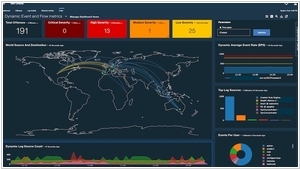Darktrace vs IBM QRadar
August 05, 2023 | Author: Michael Stromann
See also:
Top 10 SIEM software
Top 10 SIEM software
Darktrace and IBM QRadar are two leading cybersecurity solutions, but they have distinct features and approaches to address different aspects of organizational security needs. Darktrace's strength lies in its use of artificial intelligence (AI) and machine learning to create a self-learning Cyber AI platform. It excels in anomaly detection, identifying abnormal behavior in real-time and responding proactively to emerging threats across an organization's network and cloud environments. Darktrace's focus on autonomous response capabilities empowers security teams to stay one step ahead of sophisticated attacks. Its approach is particularly advantageous for organizations seeking proactive threat detection and response.
On the other hand, IBM QRadar is a robust and scalable security information and event management (SIEM) solution. It offers a centralized view of an organization's security landscape, correlating data from various sources to identify potential threats and vulnerabilities. QRadar's strength lies in its ability to analyze vast amounts of data and generate actionable insights, coupled with its extensive support for integration with third-party security tools. Additionally, QRadar is known for its strong compliance management capabilities, offering predefined reports and automated processes to meet regulatory requirements effectively.
Another key difference lies in their deployment models. Darktrace typically offers a cloud-native deployment, making it an attractive option for organizations seeking the benefits of cloud-based scalability and ease of management. In contrast, IBM QRadar can be deployed on-premises or in a hybrid environment, catering to organizations with specific data privacy and compliance needs. This difference in deployment options allows organizations to choose the model that aligns best with their infrastructure and security strategy.
See also: Top 10 SIEM software
On the other hand, IBM QRadar is a robust and scalable security information and event management (SIEM) solution. It offers a centralized view of an organization's security landscape, correlating data from various sources to identify potential threats and vulnerabilities. QRadar's strength lies in its ability to analyze vast amounts of data and generate actionable insights, coupled with its extensive support for integration with third-party security tools. Additionally, QRadar is known for its strong compliance management capabilities, offering predefined reports and automated processes to meet regulatory requirements effectively.
Another key difference lies in their deployment models. Darktrace typically offers a cloud-native deployment, making it an attractive option for organizations seeking the benefits of cloud-based scalability and ease of management. In contrast, IBM QRadar can be deployed on-premises or in a hybrid environment, catering to organizations with specific data privacy and compliance needs. This difference in deployment options allows organizations to choose the model that aligns best with their infrastructure and security strategy.
See also: Top 10 SIEM software





